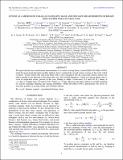Files in this item
Spitzer as a microlens parallax satellite : mass and distance measurements of the binary lens system OGLE-2014-BLG-1050L
Item metadata
| dc.contributor.author | Zhu, Wei | |
| dc.contributor.author | Udalski, A. | |
| dc.contributor.author | Gould, A. | |
| dc.contributor.author | Dominik, M. | |
| dc.contributor.author | Bozza, V. | |
| dc.contributor.author | Han, C. | |
| dc.contributor.author | Yee, J. C. | |
| dc.contributor.author | Calchi Novati, S. | |
| dc.contributor.author | Beichman, C. A. | |
| dc.contributor.author | Carey, S. | |
| dc.contributor.author | Poleski, R. | |
| dc.contributor.author | Skowron, J. | |
| dc.contributor.author | Kozłowski, S. | |
| dc.contributor.author | Mróz, P. | |
| dc.contributor.author | Pietrukowicz, P. | |
| dc.contributor.author | Pietrzyński, G. | |
| dc.contributor.author | Szymański, M. K. | |
| dc.contributor.author | Soszyński, I. | |
| dc.contributor.author | Ulaczyk, K. | |
| dc.contributor.author | Wyrzykowski, Ł. | |
| dc.contributor.author | Gaudi, B. S. | |
| dc.contributor.author | Pogge, R. W. | |
| dc.contributor.author | DePoy, D. L. | |
| dc.contributor.author | Jung, Y. K. | |
| dc.contributor.author | Choi, J.-Y. | |
| dc.contributor.author | Hwang, K.-H. | |
| dc.contributor.author | Shin, I.-G. | |
| dc.contributor.author | Park, H. | |
| dc.contributor.author | Jeong, J. | |
| dc.date.accessioned | 2015-06-08T14:10:03Z | |
| dc.date.available | 2015-06-08T14:10:03Z | |
| dc.date.issued | 2015-05-20 | |
| dc.identifier | 192927618 | |
| dc.identifier | 3a42d368-dd7b-4c5e-a0c7-cf866abc01db | |
| dc.identifier | 000354991300008 | |
| dc.identifier | 84930198056 | |
| dc.identifier.citation | Zhu , W , Udalski , A , Gould , A , Dominik , M , Bozza , V , Han , C , Yee , J C , Calchi Novati , S , Beichman , C A , Carey , S , Poleski , R , Skowron , J , Kozłowski , S , Mróz , P , Pietrukowicz , P , Pietrzyński , G , Szymański , M K , Soszyński , I , Ulaczyk , K , Wyrzykowski , Ł , Gaudi , B S , Pogge , R W , DePoy , D L , Jung , Y K , Choi , J-Y , Hwang , K-H , Shin , I-G , Park , H & Jeong , J 2015 , ' Spitzer as a microlens parallax satellite : mass and distance measurements of the binary lens system OGLE-2014-BLG-1050L ' , Astrophysical Journal , vol. 805 , no. 1 . https://doi.org/10.1088/0004-637X/805/1/8 | en |
| dc.identifier.issn | 0004-637X | |
| dc.identifier.other | BibCode: 2015ApJ...805....8Z | |
| dc.identifier.other | ORCID: /0000-0002-3202-0343/work/75996782 | |
| dc.identifier.uri | https://hdl.handle.net/10023/6781 | |
| dc.description.abstract | We report the first mass and distance measurements of a caustic-crossing binary system OGLE-2014-BLG-1050 L using the space-based microlens parallax method. Spitzer captured the second caustic crossing of the event, which occurred ~10 days before that seen from Earth. Due to the coincidence that the source-lens relative motion was almost parallel to the direction of the binary-lens axis, the fourfold degeneracy, which was known before only to occur in single-lens events, persists in this case, leading to either a lower-mass (0.2 and 0.07 MΘ) binary at ~1.1 kpc or a higher-mass (0.9 and 0.35 MΘ) binary at ~3.5 kpc. However, the latter solution is strongly preferred for reasons including blending and lensing probability. OGLE-2014-BLG-1050 L demonstrates the power of microlens parallax in probing stellar and substellar binaries. | |
| dc.format.extent | 1138436 | |
| dc.language.iso | eng | |
| dc.relation.ispartof | Astrophysical Journal | en |
| dc.subject | Binaries: general | en |
| dc.subject | Gravitational lensing: micro | en |
| dc.subject | QB Astronomy | en |
| dc.subject | QC Physics | en |
| dc.subject | NDAS | en |
| dc.subject.lcc | QB | en |
| dc.subject.lcc | QC | en |
| dc.title | Spitzer as a microlens parallax satellite : mass and distance measurements of the binary lens system OGLE-2014-BLG-1050L | en |
| dc.type | Journal article | en |
| dc.contributor.sponsor | The Royal Society | en |
| dc.contributor.institution | University of St Andrews. School of Physics and Astronomy | en |
| dc.identifier.doi | 10.1088/0004-637X/805/1/8 | |
| dc.description.status | Peer reviewed | en |
| dc.identifier.url | http://adsabs.harvard.edu/abs/2015ApJ...805....8Z | en |
| dc.identifier.grantnumber | UF100010 / UF130581 | en |
This item appears in the following Collection(s)
Items in the St Andrews Research Repository are protected by copyright, with all rights reserved, unless otherwise indicated.

